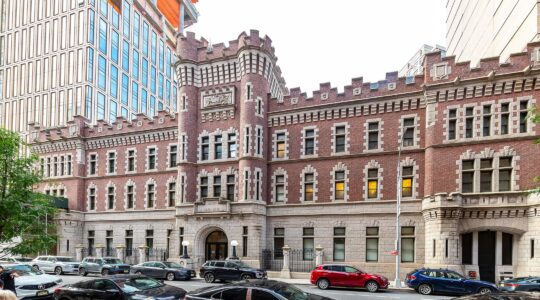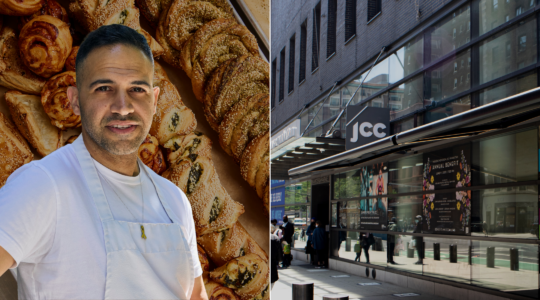“Hamilton” may be the hottest ticket in town, with its fusion of hip-hop patriotism and a colorful cast of homeboys for Founding Fathers, but not far behind in ticket sales and sentimental attachments to equally revolutionary times is the revival of “Fiddler on the Roof.”
Yes, that “Fiddler on the Roof,” the one from your grandmother’s youth. In 1964, when it began its long Broadway run that received nine Tony Awards, including Best Musical, “Fiddler” was a nostalgic recalling of shtetl life in the Pale of Settlement and in Eastern Europe — diaspora Judaism at its most insular and desperate. It was where the grandmothers of today’s Jewish grandmothers first began their journeys to America.
The musical has since spawned four Broadway revivals before this one (and hundreds of regional productions around the world). For over 50 years the Great White Way has hosted a “Fiddler on the Roof” in one of its palatial theaters, where the fiddlers stay in orchestra pits and where the house is filled with very rich men (and women) — the kind that Tevye, the musical’s put-upon protagonist, could never have become in Russia, or nearly anywhere else.
This superb new production, playing at the Broadway Theatre and starring Danny Burstein as Tevye, is a refreshing return to the hardscrabble villages that once represented the primary home for Jews. And it couldn’t have arrived at a better time. With tiny Israel generating both global enmity and envy, and Jews widely regarded as members in good standing of the American mainstream — far from the steerage stench of the Lower East Side — “Fiddler” is probably a shock to many for whom Jews are Adam Sandler and Sarah Silverman — not Sholem Aleichem.
Before “Fiddler,” the pre-American lives of Jews, not to mention their traditions, was very much a mystery. And that’s why in addition to being a musical, it was also a tutorial on why the Chosen People were forced to immigrate to the Goldene Medina in the first place.
Auschwitz had only been liberated less than two decades before “Fiddler’s” opening night. The moral rupture of the Holocaust was not yet a cultural touchstone. Aside from a sugarcoated Anne Frank, the genocide of the Jews was scarcely uttered in polite conversation. Jews seeking safe havens both before and after the Holocaust received far less global attention than the Syrian refugee crisis of today.
Depictions of Jews in popular culture were rare sightings, too. The iconic film, “Casablanca,” amazingly never uttered the word “Jew.” “Bridget Loves Bernie,” a highly rated TV sitcom from the early 1970s about an interfaith marriage, was taken off the air after only one season. Ironically, this programming decision was consistent with the penultimate storyline of “Fiddler.” Throughout the play Tevye bends to the marital wishes of his daughters. He accepts change in the guise of progress, and his own paralysis. Ultimately, everything, including his land, is taken away. Having a daughter marry a gentile is one tradition, however, where Tevye insisted on holding his ground.
Today intermarriage is as much a fixture of modern life as is divorce, and dancing the hora on a Broadway stage is hardly as exotic as it must have seemed in 1964. (The choreography in this production of “Fiddler” is especially enchanting.) But many people in the audience who have attended Passover seders, or spun a dreidel on Chanukah, might not realize, or have by now forgotten, that Jewish-Americans were once immigrants themselves.
“Fiddler on the Roof” once introduced theatergoers to the old customs and faraway haunts of an upwardly mobile religious minority. The fictional Anatevka was where Jewish immigrants originally came from, and the end of the play, with its mass caravan of pushcarts, explained why they had to leave. The original production allowed the shtetl of the mind to steady the sentimental heart. Before “Fiddler,” Jewish origins, and their “Traditions,” were neither well known nor ever displayed.
Today, however, those who see “Fiddler,” including Jews, will regard the shtetl — sentimentalized and sanitized though it may be — as positively prehistoric. Why are Jews dressed that way? Why is dancing with Cossacks such a risqué endeavor? Jews are supposed to be investment bankers, not impoverished milkmen.
Jewish-Americans, nowadays, are a people undeserving of a hyphen. In the murky multicultural world of identity politics, Jews are regarded as privileged wealthy white people. “Jewish Lives Matter” will not appear on any T-shirt. The solidly upper middle class — and the billionaires who founded Google and Facebook — surely have no claims on victimhood. Besides, Jews are associated with Israel, which many people believe is a colonialist country that makes refugees rather than absorbs them.
With aliyah on the rise all throughout Europe, the wearing of Jewish symbols more forbidden than shellfish, and Jewry fearing for its lives as if the Czar were back in town, “Fiddler” recalls an era, before the existence of Israel, when Jews had no homeland, were unwelcome elsewhere, and yet were determined to maintain their traditions despite the challenges of modernity and the melting pot.
At a time when assimilation dominates the Pew study, and Jewish college students are being asked to prove that they are not sinister agents of a colonial power, it’s nice to be reminded of a time when Jews were very much an immigrant group, with a unique immigration story — and not just some nouveau strain of America’s WASP aristocracy.
Thane Rosenbaum, a novelist and cultural critic, is the author, most recently, of “How Sweet It Is!”
The New York Jewish Week brings you the stories behind the headlines, keeping you connected to Jewish life in New York. Help sustain the reporting you trust by donating today.




